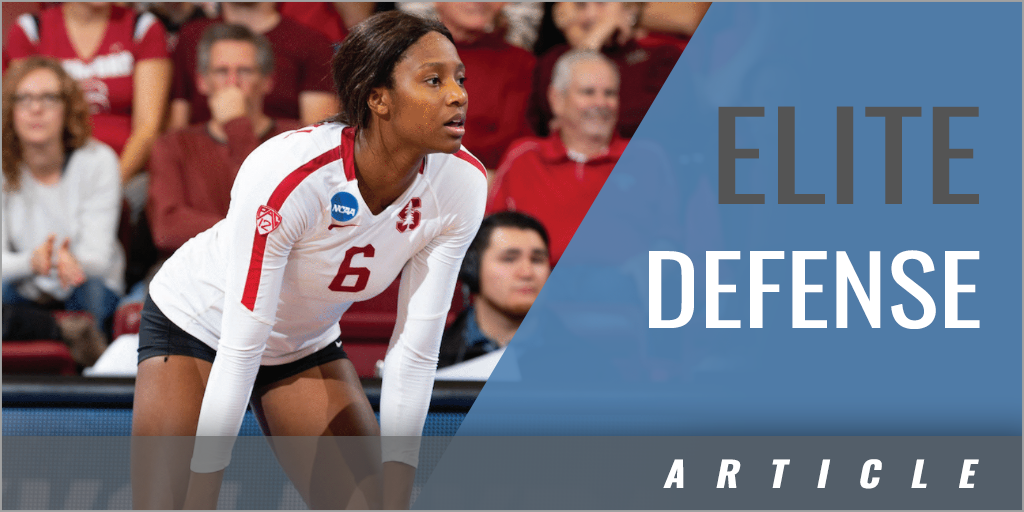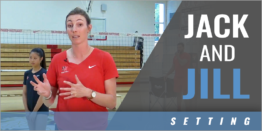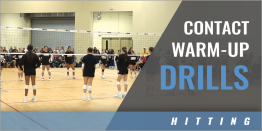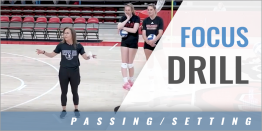|
By: Jim Miret, Front Range Volleyball Originally Published in: Coaching Volleyball Copyright and Provided by: American Volleyball Coaches Association Early on in my coaching career I was exposed to the idea that players must get low and be stopped on defense to be great defenders. Since then, I often hear from my players who come back from high school seasons and college camps that these instructions are what they have learned are important elements to good defense. Obviously, no coach wants players moving around the court aimlessly or with no intent as they play defense. However, to train a player to get stopped is to work against the very athletic nature of the skill of defense. Additionally, instructing a player to get their body into a low position works against the body mechanics that will allow them to move to the ball quickly or to change directions quickly.
The intent of this article is to apply a critical eye to defensive training and the specific movement patterns of elite defenders. It is only by examining the highest levels of our sport (international and professional volleyball teams) that we can actually learn what the high-level defensive skills are, and can determine the skill progressions that we should be working on with all of our athletes. What similarities do we see among the top women's players in the world as they try to respond and react to the fastest offenses and attackers in the world? As offenses have gotten faster, the adjustment time for defensive players in volleyball has consequently gotten shorter. When we examine defenders in slow motion we see several consistent themes. Most players are actually in what would be considered a high athletic position prior to contact, which is optimal for quick movement around the court. Their hips are loaded with their torso upright, they are moving quickly on the balls of their feet, and they are timing split-steps with the contact of the attacker's swing on the ball. Close to the contact of the attacker we can see that the feet of these defenders are slightly off the ground during their split-step, and their torso is in a higher athletic position as they prepare to move. Players in these high postures at contact will then transition into a lower body posture to play the ball, particularly if the ball is hard-driven to the floor. Split-steps and quick foot movements are not unique to volleyball - we observe the same techniques in many other sports; here are a few examples. Baseball infielders and outfielders, while the pitch is being delivered, usually walk into some kind of a split-step movement. The split-step creates movement prior to the hitter making contact with the ball and places their feet in the air as or slightly after the ball is being contacted by the bat. In the sport of tennis, players in serve receive will often be in a constant state of motion rocking back and forth before the serve or running in place and timing a split-step around the time the server will contact the ball. These athletes are engaging the stretch-shortening cycle of their muscles (a topic covered in a previous article) to enable them to move quickly in response to the ball coming off the bat or the racket. We can observe very similar actions and movements when we critically study top-level defensive players in volleyball. Understanding why this movement pattern is efficient (and therefore utilized by many of the top players in the world) is an essential part of the puzzle. An athlete's hips starting in a loaded position helps that player to move quickly and effectively to adjust to the attack. Quick foot movements into a split-step help load the muscles and increases their responsiveness to move to a hard-driven spike. A player's torso in an upright position allows that player great vision and movement freedom. When coaches instruct their players to get stopped or to get low on defense when they should be adjusting to an attacker's approach and the formation of the block, we put that player in a figurative box – not only are we making it harder for them to play the ball but we are also taking away their freedom to be athletic. Think about when you are in a deep squat - are you able to move quickly or change directions easily? The lower a player's hips or shoulders are at spike contact makes it much more difficult for them to move from the one spot that they were occupying to respond to the ball. Volleyball is without doubt a quick and responsive sport. Players must make instantaneous decisions based on a complex set of visual cues. I would be remiss if I didn't mention the visual reading that must happen when playing good defense. For youth as well as many college players, decoding the visual noise that happens as a set goes out to a hitter and a block forms in front of the hitter while other defenders are sharing defensive responsibilities is a very complex visual field to decipher. Teaching players what the relevant cues are is another important factor in teaching them how to become good defenders. Therefore, proper movement mechanics are crucial to helping players execute high-level defensive skills and react to the visual cues that they are reading. What about ankle flexion? I often hear coaches mention ankle flexion as a method for players to get low on defense in volleyball. In my examination of international video this is a move that I see used very seldom. Obviously, there is some ankle flexion as players get lower, but I don't see that as the main element to the move to get lower. The move I see being utilized most often is from the high-body-posture players who will move their hips down to the ball and their shins will be more vertical to the ground. There is an exception when a player goes down to one knee; this is when we can see ankle flexion in the other leg. However, most commonly we see players moving from the very high body posture into a lower hip position to receive low spikes. In video examples (see the digital issue) you should see some consistent themes. Players will be in some kind of quick foot movement, adjusting their position on the court almost entirely during the time the ball is in flight from the setter to the attacker. The closer the ball gets to the attacker, the more the player will try to time their split-step to the time the attacker is contacting the ball. In some instances, you will see players executing several split-steps in a row as the attacker gets ready to contact the ball. These athletes are in constant motion, and their feet are never really stopped during the play. They start the play by moving in a high athletic or hip-loaded position with an upright torso, and will drop their hips to play a low ball instead of bending over at the waist. When coaches instruct their players to get stopped or to get low on defense when they should be adjusting to an attacker's approach and the formation of the block, we put that player in a figurative box... While many of these players are starting in the same position (hips loaded and torso upright), there are many defensive techniques that can be used to play the ball, depending on the read a player makes on the ball. Again, this is a prime example of the athletic freedom players are able to express when they start in a high athletic position as opposed to a low and stopped position. Defenders will see and be asked to play a wide array of attacks in a match, so it is essential that they have different techniques to play different balls. We have identified a series of movement patterns that we think are important to playing good defense:
I don't just believe that defenders playing defense in a hip-loaded and torso-upright position is efficient, I can see that it is an effective and athletic movement pattern from the mentioned videos. With 2020 being an Olympic year, we will all have many opportunities to observe the very best volleyball players executing their skills at the highest levels. I challenge you to take a look at the different defenses and defenders from teams around the world, to see these defensive techniques in action. But most importantly, we must train our players in a way that allows them to express their athleticism. Our players are athletes, so let's give them the tools to be athletic! |








